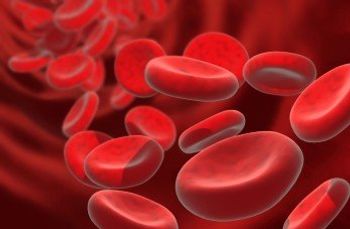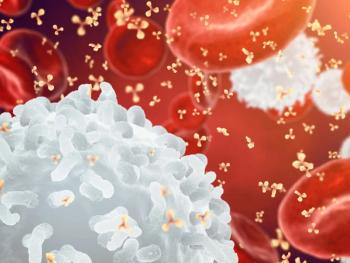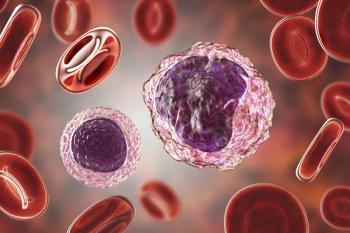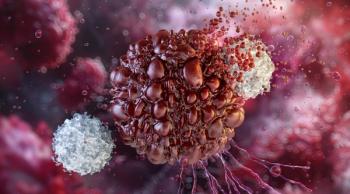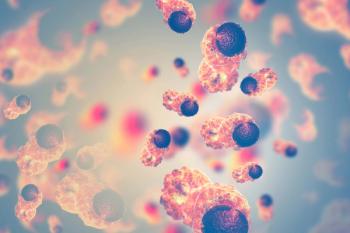
Oncology NEWS International
- Oncology NEWS International Vol 11 No 2
- Volume 11
- Issue 2
Optimal Dose for Initial Donor Lymphocyte Infusion Reported for Relapsed CML
ROME-Best outcomes from donor lymphocyte infusion in chronic myelogenous leukemia (CML) occur when the first dose does not exceed 0.2 × 108 mononuclear cells/kg, Cesare Guglielmi, MD, reported in a presentation at the 43rd Annual Meeting of the American Society of Clinical Oncology.
ROMEBest outcomes from donor lymphocyte infusion in chronic myelogenous leukemia (CML) occur when the first dose does not exceed 0.2 × 108 mononuclear cells/kg, Cesare Guglielmi, MD, reported in a presentation at the 43rd Annual Meeting of the American Society of Clinical Oncology.
Dr. Guglielmi, who is in the Department of Cellular Biotechnology and Hematology at La Sapienza University in Rome, reported data from a retrospective study of 344 CML patients treated in 51 transplant centers affiliated with the European Group for Blood and Marrow Transplantation (EBMT). He said that lower starting doses decrease both morbidity and mortality, with a beneficial effect on overall and failure-free survival.
"Donor lymphocyte infusion can produce durable remissions in patients with CML who relapse after an allogeneic stem cell transplantation. However, the best modality to administer the infusions is unclear. The objective of this study was to evaluate how the outcome of CML relapse was affected by the cell dose of the first donor lymphocyte infusion," Dr. Guglielmi said.
Methods and Design
The initial cell dose (number of mononuclear cells × 108/kg received in the first infusion) was available for 298 patients. This ranged from 0.002 to 24.4 × 108/kg, with a median initial dose of 1 × 108/kg. For purposes of this analysis the investigators stratified patients into three groups according to the initial dose they had received. Group A (n = 98) was the low-dose group, ranging from 0.002 to 0.20 × 108/kg, with a median dose of 0.1 × 108/kg. Group B (n = 107) was the intermediate-dose group, ranging from 0.21 to 2.0 × 108/kg, with a median dose of 1 × 108/kg. Group C (n = 95) was the high-dose group, ranging from 2.1 to 24.4 × 108/kg, with a median dose of 3.5 × 108/kg. Dr. Guglielmi said that more than one infusion was given to 62%, 20%, and 5% of patients in the low-, intermediate-, and high-dose groups, respectively, and that the number, dose, and frequency of additional infusions did not correlate with the initial dose.
Outcome Analysis
Responses were seen with single or multiple infusions, irrespective of the initial cell dose. The outcomes analyzed were graft-vs-host disease after donor lymphocyte infusion (acute grade 2-4 and/or chronic graft-vs-host disease), myelosuppression (neutropenia and/or thrombocytopenia), response (cytogenetic and/or molecular complete remission), overall survival (OS), failure-free survival (FFS), and donor lymphocyte infusion-related mortality.
Dr. Guglielmi said that 44% of patients developed acute grade 2-4 and/or chronic graft-vs-host disease after donor lymphocyte infusion, 18% developed myelosuppression, and 69% had a response. The incidence of GVHD, along with the incidence of myelosuppression, varied with the size of the initial dose, but the response rate did not (see Table 1).
"Group A had the best survival, and group C had the worst," Dr. Guglielmi said. The initial dose level had a strong influence on survival for the first 9 months after infusion, at which point the survival curves became parallel. Similarly, the low-dose patients had the best failure-free survival and the high-dose patients the worst, but again, after 9 months the curves became parallel.
The outcome analysis was then adjusted for patient age (< 40 vs > 40 years), donor type (human leukocyte antigen-identical sibling vs unrelated volunteer), donor gender, disease phase at transplant (first chronic phase vs more advanced), T-cell depletion, interval from transplant to donor lymphocyte infusion (< 2 vs > 2 years), graft-vs-host disease prior to infusion, relapse type (molecular/cytogenetic vs hematological vs transformed), and date of infusion (1988 to 1994 vs 1995 to 1998).
After adjustment, the lowest initial cell dose was associated with less graft-vs-host disease, less myelosuppression, similar response rate, better OS, better FFS, and less donor lymphocyte infusion-related mortality. "The risk of dying of donor lymphocyte infusion complications increased by a factor of 10 in group B, and 18 in group C, compared to group A," Dr. Guglielmi said. "Patients with relapsed CML who start donor lymphocyte infusion with a dose higher than 0.2 × 108/kg experience significant morbidity and mortality that can be reduced by using a lower starting dose of donor cells."
Articles in this issue
almost 24 years ago
R115777 Has Significant Activity in CML and Myelofibrosisalmost 24 years ago
National Cancer Prevention Campaign Discussedalmost 24 years ago
CHOP Plus Rituxan Proves Cost-Effective in B-Cell Lymphomaalmost 24 years ago
Lung Cancer Screening Protocol Moves Forwardalmost 24 years ago
Cancer Prevention Research Hampered by Lack of Biomarkersalmost 24 years ago
Rituximab Improves Efficacy of Chemotherapy for Follicular Lymphomasalmost 24 years ago
Long Survival Confirmed in CML Patients Who Respond to InterferonNewsletter
Stay up to date on recent advances in the multidisciplinary approach to cancer.


